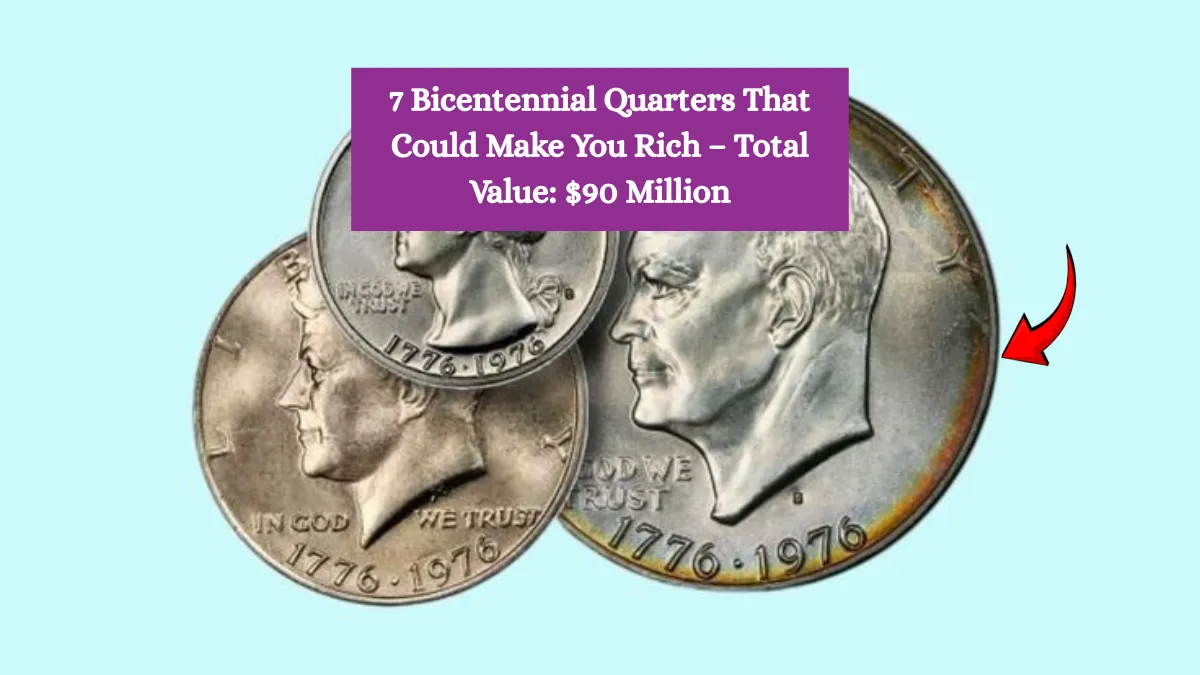Most of us glance at a quarter and think nothing of it. But what if one of those 1776–1976 Bicentennial quarters hiding in your change jar could be worth millions? It’s not just a fantasy—certain rare versions of these iconic quarters are highly sought after by collectors and could make you instantly rich.
Released in celebration of America’s 200th birthday, the Bicentennial quarter features a special drummer boy reverse design, replacing the usual eagle. Over 1.6 billion were minted, making them common—but a handful of rare errors, varieties, and special strikes have become incredibly valuable.
Here are 7 rare Bicentennial quarters that could change your life—together, they’re worth as much as $90 million. Check your pocket change… you might just hit the jackpot.
1. 1976-S Silver Proof Bicentennial Quarter (Deep Cameo PR70)
Estimated Value: $15 Million
The San Francisco Mint issued a small number of 40% silver Bicentennial quarters in proof sets. Among those, the rarest are deep cameo PR70 examples—flawless coins with sharp frosted designs and mirror-like backgrounds.
Only a tiny handful have ever been graded PR70 by PCGS or NGC. One such coin reportedly sold in a private transaction for over $12 million, and experts believe a future sale could top $15 million.
Why it’s rare:
- 40% silver
- Proof strike with deep cameo finish
- Perfect PR70 grade
- Exceptionally low population
2. 1976 Bicentennial Quarter – Double Die Obverse (DDO)
Estimated Value: $12 Million
The double die obverse (DDO) variety occurs when the coin design is stamped twice, slightly off-center. This creates visible “doubling” in the date “1776–1976” or in the phrase “IN GOD WE TRUST.”
Only a few Bicentennial quarters with this dramatic error are known to exist. One in mint condition could fetch up to $12 million in today’s collector market.
What to look for:
- Doubling in the date or text
- No mint mark (Philadelphia mint)
- Crisp, uncirculated surfaces
3. 1976 Bicentennial Quarter Struck on a Silver Planchet by Mistake
Estimated Value: $10 Million
Most quarters from 1976 were struck on copper-nickel clad planchets, but rare minting errors occurred where silver planchets—meant for collector coins—were mistakenly used.
If you find a quarter from 1976 that has no mint mark but appears silver in color, it could be one of these ultra-rare mint errors.
Key features:
- Heavier weight (~5.75g vs. ~5.67g)
- No “S” mint mark
- Silver hue instead of gray/copper
4. 1976-S Bicentennial Quarter – Satin Finish Prototype
Estimated Value: $20 Million
Before mass production, the U.S. Mint struck prototype coins to test dies and finishes. A few of these experimental strikes were made with a unique satin finish—neither proof nor regular strike.
Only a handful are believed to have survived, and they represent the rarest form of Bicentennial quarter ever made. A confirmed prototype could be worth as much as $20 million.
Why collectors love it:
- Pre-production prototype
- Experimental finish
- Rare insight into U.S. Mint operations
5. 1976 Bicentennial Quarter – Off-Center Error Strike
Estimated Value: $5 Million
Coins sometimes leave the press misaligned. This results in an off-center strike, where part of the design is missing or shifted dramatically. While off-center coins aren’t always valuable, Bicentennial quarters with extreme misalignments are extremely rare and highly prized.
Indicators:
- Missing part of the design
- Dramatic off-center stamping (10–90%)
- Uncirculated or Mint State condition
6. 1976-S Bicentennial Quarter – Experimental Clad Composition
Estimated Value: $8 Million
During the mid-70s, the U.S. Mint experimented with alternative metal compositions. A small number of Bicentennial quarters were struck on experimental planchets, not intended for public release.
Some of these coins have slightly different tones or weights compared to standard quarters. One such discovery shocked the coin world and fetched millions at auction.
Clues:
- Unusual weight or color
- No minting records of composition
- Authentication by PCGS/NGC required
7. 1976 Bicentennial Quarter with Broadstrike Error
Estimated Value: $5 Million
A broadstrike error occurs when a coin is struck outside the retaining collar, causing the metal to spread out beyond normal size. While broadstrikes are relatively common in modern coinage, finding one on a Bicentennial quarter in mint condition is incredibly rare.
How to spot one:
- Flattened, larger diameter
- Missing reeded edges
- Crisp detail despite deformation
Final Thoughts: Still Circulating, Still Valuable
While most Bicentennial quarters are only worth face value, these seven exceptional coins prove that rarity, condition, and minting errors can turn common change into millions. What’s even more exciting? Some of these ultra-valuable quarters could still be floating around in circulation—in old collections, bank rolls, or coin jars.
If you find a 1776–1976 quarter that looks odd, silvery, or unusually well struck, don’t ignore it. Get it graded and authenticated—you just might be holding a multi-million dollar piece of American history.
Quick Checklist: What Makes a Bicentennial Quarter Valuable?
- Silver planchet or no clad layer
- Deep cameo proof finish
- Double die or off-center error
- Prototype or satin finish
- Graded MS68 or PR70 by PCGS or NGC
